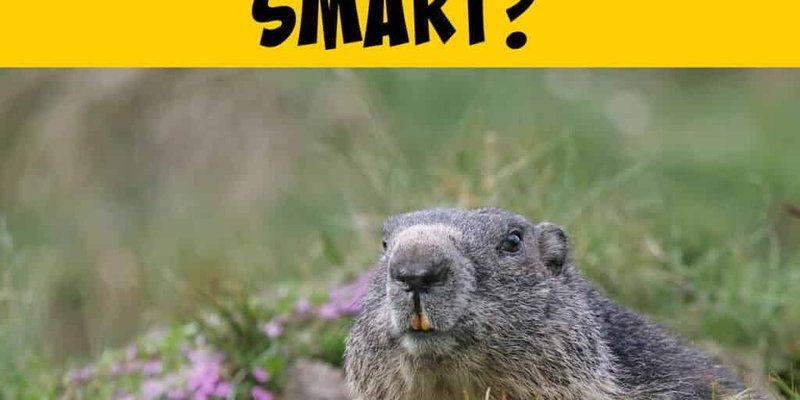
Imagine them as tiny, furry urban planners. They dig intricate burrows, communicate with one another, and even adapt to their environments. Their intelligence allows them to thrive in various habitats, from woods to urban areas. So, let’s dive deeper into the fascinating cognitive world of groundhogs.
Understanding Groundhog Intelligence
Groundhogs demonstrate a range of cognitive abilities that might surprise you. Their intelligence is not just about instinct but involves learning and adaptation. For instance, they memorize the layout of their environment and can even recognize predators. This situational awareness helps them survive and thrive.
You might be wondering how we can measure such intelligence. While it’s not as straightforward as giving them a test like you might see in a classroom, researchers often look at behaviors like problem-solving and social interactions. Groundhogs have shown an ability to navigate their surroundings efficiently, which is a sign of their cognitive skill.
Learning Through Experience
Groundhogs, like many animals, learn from their experiences. If they encounter a new threat, they can change their behavior based on what they’ve learned. For example, if a groundhog narrowly escapes a predator, it will likely be more cautious in that area in the future. This ability to adapt is a hallmark of intelligence in the animal kingdom.
Moreover, groundhogs can also communicate with one another. They use a variety of vocalizations, body language, and even scent marking to convey messages. This communication is crucial for establishing territory and warning others of danger, showcasing their social intelligence.
Behavioral Traits of Groundhogs
One of the most interesting aspects of groundhog behavior is their burrowing habits. Groundhogs are expert diggers, creating complex tunnel systems that can stretch up to 30 feet long. These burrows serve as homes but also as safe havens from predators.
In fact, these tunnels have multiple chambers—one for sleeping, one for storing food, and even a bathroom area! This kind of organization shows not only their intelligence but also an understanding of how to live comfortably and securely. Just think of it as their version of a cozy apartment.
Seasonal Adaptations
Groundhogs are also known for their seasonal behaviors. They hibernate during winter, which is a fascinating survival strategy. Before hibernation, they spend the summer and fall months foraging for food to build up fat reserves. This seasonal adaptation demonstrates their ability to plan ahead—something we often associate with higher intelligence.
During hibernation, groundhogs can lower their body temperature significantly and slow their heart rate, allowing them to conserve energy. When they wake up in the spring, they’re ready to eat and breed, showing how their bodies have adapted to their environment over time.
Social Structure and Communication
Groundhogs may seem solitary, but they do exhibit social behaviors. When you see them in urban settings, you might notice them living relatively near each other. They communicate primarily through vocalizations, which vary in sound depending on whether they’re alerting others to danger or signaling for mating.
These communication methods can be as varied as chirps, whistles, and even growls. Each sound serves a specific purpose, demonstrating their ability to convey important messages within their social structures. It’s like having a whole language of their own!
Challenges of Urban Living
As groundhogs adapt to suburban life, they face new challenges. Traffic, human interactions, and changes in their natural habitat can be daunting. Yet, their intelligence shines through as they learn to navigate these complexities—often finding ways to coexist with humans.
For instance, they may learn to forage for food in gardens or parks while avoiding busy roads. This cleverness indicates a level of problem-solving ability that many people might not expect from a creature that’s often seen as just a pest.
Groundhogs and Their Predators
In the wild, groundhogs have a variety of predators, such as foxes, hawks, and dogs. Their intelligence plays a crucial role in helping them avoid these dangers. Groundhogs rely on their keen senses to detect threats and use their burrowing skills to create escape routes.
They’re quick to react, using their agility to dart back to safety when danger approaches. Additionally, the ability to stay alert and aware of their surroundings helps them avoid becoming a meal for hungry predators. Their natural instincts combined with learned behaviors allow them to navigate a landscape filled with hazards effectively.
Conservation and Protection
Like many wild animals, groundhogs face threats from habitat loss and human encroachment. Understanding their behavior and cognitive skills can help with conservation efforts. By protecting their natural habitats, we give these smart animals a chance to thrive.
You might wonder how you can help. Simple actions, like creating wildlife-friendly spaces in your garden or avoiding the use of harmful pesticides, can make a big difference for groundhogs and other local wildlife.
So, how smart is a groundhog? It turns out they’re quite intelligent in their own right! From their problem-solving skills to their complex social interactions, groundhogs demonstrate a rich tapestry of cognitive abilities that help them survive and thrive in a variety of environments.
Next time you see a groundhog, take a moment to appreciate the little genius at work. They’re not just cute creatures showing off their burrowing skills; they’re clever animals with a robust understanding of their surroundings. By learning more about them, we can foster a deeper respect for wildlife and help protect the habitats they call home.

